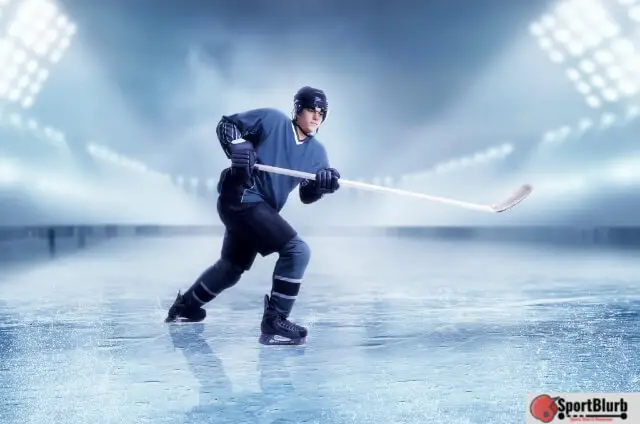Last Updated on October 21, 2023 by Alex PT
Field Hockey is played on grass with a small, lightweight ball, emphasizing agility and precision. Ice Hockey is played on ice with a puck, involving intense physical contact and speed. Ice Hockey is often considered tougher due to the physical demands and skating skills required.
Field Hockey VS Ice Hockey – Key Differences

We’ve listed some major differences between the two sports for a better understanding.
Field Dimensions
Ice hockey has a smaller rink size measuring 61 meters (200 ft) × 30.5 meters (100 ft) with a corner radius of approximately 8.5 meters (28 ft). The standard size of a field hockey playfield is much larger than the rink of ice hockey. It is a rectangular field measuring approximately 91.4 meters (100 yards) × 55 meters (60.1 yards).
Playing Surface
The playing surface is the most noticeable difference between the two sports. One is played on the ice while the other is on a grass field. In infield hockey, a water-based astroturf is more preferable because it helps the ball to move really fast. It is a more preferable option to the astroturf with a black pebble that slows down the pace of the ball. In ice hockey, bad ice isn’t preferable because it causes the puck to be harder to play with or bouncy.
Structure Of The Game
Infield hockey, a game is played over a total duration of 70 minutes with 35 minutes for the first half and 35 minutes for the second half. In some rare cases, a field hockey game may be played within 60 minutes and divided into four quarters of 15 minutes. In ice hockey matches, each game is structured as a 60-minute game which is divided into three-quarters of 20 minutes each. Since the ice needs to be maintained frequently, the game of ice hockey does not have two halves.
Number Of Players
Field hockey has more number of players in a single team. A field hockey team consists of 11 players: 1 goalie, 3 defenders, 4 midfield, and 3 forwards. Whereas ice hockey only consists of 6 players in a single team. This includes a goalie, 2 defensemen, and 3 forwards.
Stickhandling
In ice hockey, there are no restrictions on players to stickhandle with the front and back of their stick blade. However, field hockey has no offsides. You can simply run around on the pitch anywhere.
Scoring
There are restrictions on the scoring area where players are allowed to score in the game of field hockey. You can only score from within the D area. The D area is normally a semi-circle measuring about 15 meters at the point from the goalposts. No goal will be counted if the ball was shot from outside the D area. However, that’s not the case with ice hockey. As a matter of fact, you can score from anywhere on the rink. If your shot goes in, no matter where it is shot, it will be counted.
Goalies
There are normally lower-scoring attempts in field hockey because of the small size of the scoring area with a save percentage of about 70%. The padding of the field hockey goalie isn’t as big as that of ice hockey and the goalie uses a similar playing stick like other players. Also, the netting of the goal is quite larger. However, in ice hockey, the goalie usually faces a higher volume of shots in a single game with a save percentage of about 91.5%. Goalies in ice hockey have larger padding with a smaller net to cover. Also, goalies in ice hockey have a larger stick with a different paddle at the bottom.
Offsides
In ice hockey, an offside is determined by two large blue lines. If a player crosses the blue line before the puck crosses it, then the player is ruled offside. The offside rule was established to encourage passing in the game of ice hockey as it helps remove most of the advantages enjoyed by the forwards. Two things happen when a player is ruled offside. It is either the offensive players withdraw the possession to be retained by the defensive team or the referee blows the whistle to halt the game. On the other hand, there are no offside rules in the game of field hockey. As a field hockey player, you can score from anywhere on the pitch.
Origins
Field hockey dates back as far as the earliest civilization of the world. It was in the British Isles that the modern game of field hockey was established. It was first played in ancient Egypt before the modern game started in England in the mid-1800s. In 1861, the first formal field hockey club “Blackheath Football and Hockey Club” was established. Since most of the early civilizations that played the game lived in a warm climate, there were no observances to play it on ice. Ice hockey was established after the first set of rules was written in stone in 1887.
Aggressiveness
Field hockey is not as aggressive as ice hockey. There are a lot of physical contacts, body checks, and fights in the rink of ice hockey which makes it attention on its own. The aggressiveness of ice hockey requires players to put on more protective equipment.
Penalties And Fouls
The table below consists of the dos and don’ts of field hockey and ice hockey.
| Field Hockey | Ice Hockey |
| The play will be stopped and possession is given to the opposing team when the ball hits your feet or body. | Players don’t get penalized when the puck hits any part of their body during play. Players can use their feet during the game. |
| You are not permitted to raise your stick above waist level | Players are allowed to raise their stick above the waist level but if it mistakenly hits another player above the neck it is a penalty |
| An opponent must not be attacked by two players it must always be in a one-on-one situation time | An opponent player can be attacked by multiple players. It is not a must that it should be a one-on-one situation |
| You must face your opponent shoulder to shoulder or directly, players can’t be tackled from behind | You can tackle an opposing player from behind but must play not hold a hook or trip, it should be toward the puck |
| You must not touch your opponent with the stick on any occasion | You can touch the opponent with your stick but it must not be too aggressive |
Is field hockey or ice hockey more popular?
Global Reach
Field hockey enjoys a broad global outreach, with over 100 countries registered under the International Hockey Federation. It is vastly popular in the Netherlands, Australia, India, Pakistan, and parts of Europe and South America. Ice hockey, in comparison, has a narrower global reach and is mostly concentrated in countries with colder climates, notably Canada, the United States, Russia, and Finland. However, it’s also starting to gain popularity in other regions.
Participation Levels
When considering participation rates, one can argue that field hockey leads the way. This can be attributed to the lower equipment costs and the lesser infrastructure requirements compared to ice hockey. On the contrary, ice hockey comes with significant safety equipment and ice-rink infrastructure, which might contribute to a lower participation rate. Nonetheless, in regions where ice hockey is prevalent, participation levels are high.
| Sport | Level of Participation |
|---|---|
| Field Hockey | High |
| Ice Hockey | Moderate |
Media Coverage
Due to its localized fan base, ice hockey enjoys heavy media coverage in countries where it’s popular. This is particularly evident in North America, where the National Hockey League commands a massive viewership. Comparatively, field hockey has more widespread but thinner coverage due to its global reach.
Olympic Recognition and Official Competitions
Both sports have been recognized by the Olympics, which adds to their global recognition. Field hockey has been an Olympic sport since 1908, with women’s field hockey introduced in 1980. Ice hockey entered the Olympic games in 1920, with women’s ice hockey joining in 1998. Official international competitions exist for both sports, highlighting their worldwide popularity.
Popularity in Schools
The prevalence of these sports in schools indirectly measures their popularity. Field hockey tends to be more popular in schools, especially those located in warmer climates where maintaining an ice rink is impractical. That said, within colder climates such as Canada or Northern Europe, ice hockey is a popular school sport.
Is ice hockey harder than field hockey?
Comparing the difficulty of ice hockey and field hockey is subjective and depends on individual preferences and physical abilities. Both sports have unique challenges:
Ice Hockey:
- Physical Demands: Ice hockey is known for its physicality, with body checking and collisions being integral to the game. Players need strength, endurance, and the ability to skate proficiently.
- Skating Skills: Ice hockey demands advanced skating abilities, which can be a significant barrier for newcomers. Learning to skate at high speeds while handling a puck is challenging.
- Puck Control: Manipulating a puck on the ice with a stick requires fine motor skills and precision.
- Equipment: Ice hockey gear, including heavy padding, can be cumbersome and uncomfortable.
Field Hockey:
- Agility and Precision: Field hockey prioritizes agility, quick decision-making, and precision. Ball control with a curved stick is a skill that requires practice.
- Running and Endurance: Field hockey involves continuous running on grass, demanding cardiovascular endurance and stamina.
- Less Physical Contact: While physical contact occurs in field hockey, it is generally less intense and frequent compared to ice hockey.
- Lightweight Ball: Field hockey uses a lightweight ball, making it more forgiving for beginners in terms of impact.
Closing Thoughts
Field hockey and ice hockey are quite similar in some aspects but they still have their differences. If you’re a beginner or a fan looking to venture into either of the two sports, this informative article will guide you through the similarities and differences for better understanding. We’ve come to the closing chapter of this informative article. We hope you were able to find good and reliable resources in your quest to know the differences between field hockey and ice hockey. If you have any questions or comments about the article topic, don’t hesitate to contact us. Thanks!
References:
https://www.morrant.com/Blog/ice-hockey-field-hockey
https://hockeyanswered.com/field-hockey-vs-ice-hockey-whats-the-difference/

Hi! I’m Alex PT. I hold a Bachelor’s degree in Sports Management from Indiana University and have over seven years of valuable experience working in a Sports Event Management Company. I founded SportBlurb with the passion for bringing you the latest, most insightful, and engaging content in the world of sports. So, whether you’re a die-hard fan or want to stay informed, I’ve got you covered!

